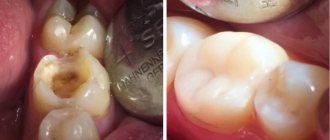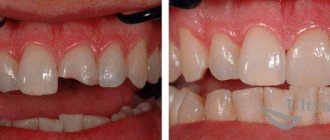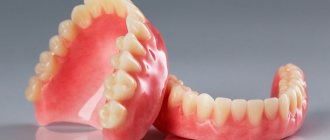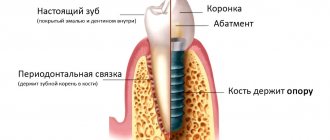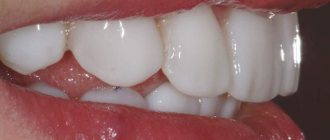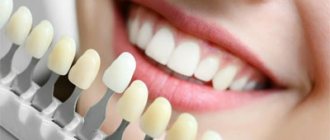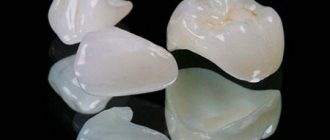Modern dentistry allows not only to treat oral diseases, but also to improve the aesthetic appearance of teeth. In other words, make your smile beautiful. The Denta-Professional clinic offers a wide range of aesthetic dentistry services.
We use only modern working methods, high-quality certified materials, and our offices are equipped with the latest equipment. Over our 21 years of existence, we have helped thousands of people gain a beautiful smile and self-confidence.
Aesthetic dentistry is a direction in dental practice, the task of which is to eliminate various defects in the appearance of teeth and dentition. According to modern beauty standards, the dentition should be smooth, and the dental units themselves should be a natural white color, with microrelief and a transparent cutting edge.
Types of aesthetic dentistry
Depending on the aesthetic task, approaches to work may be different. If a complete change in the appearance of the entire dentition is required, then usually one procedure cannot get rid of it. Complex work of several specialists will be required: gnathologist, orthodontist, surgeon and orthopedist.
If we are talking about less global changes, for example, the restoration of one or more destroyed units, chipped front teeth or changing the appearance of the smile area, the following procedures may be used:
- Restoration with composite materials
- Restoration of chewing teeth with inlays
- Aesthetic (artistic) restoration of anterior teeth
- Aesthetic restoration with veneers
Teeth whitening also falls within the scope of aesthetic dentistry.
Professional hygiene and whitening
Modern aesthetic dentistry is unthinkable without professional dental hygiene. This procedure gets rid of plaque and tartar, returns the enamel to its natural shade, strengthening it, and is also an excellent prevention of caries.
Whitening is also an important aspect of aesthetic dentistry. Modern in-office whitening techniques (when the procedure takes place in the dentist’s office) make it possible to restore the whiteness of your smile in one session. The doctor may also suggest one of the home whitening systems.
Restoration with composite materials
To restore the coronal part, dentists use composite light-curing materials, the same ones used for fillings. This procedure is usually used when a tooth with minor damage needs to be restored. The composite material is quite fragile and will not be able to fully restore functionality on chewing teeth if the chip is large.
The service life of such a restoration is individual for each patient and depends on the structural features of his teeth and physiological properties. Bad habits and oral care also have a big impact. The average lifespan of a light seal is 5 years, but it often lasts much longer.
Advantages of composites
Modern compounds used for dental restoration are distinguished by high strength, durability, and the ability to choose any shade. In this regard, many patients often go too far, wanting to have unnaturally snow-white units. The focus on media characters is commendable, but it is worth remembering that such elements require careful care, which requires time and money. Our clinic’s specialists are inclined towards the option of restoring teeth using natural-colored composites. Indications for the use of such compositions include many factors. Among them are caries in the spot stage, extensive lesions, pigmentation, and unusability of old fillings. The only disadvantage noted by experts is the gradual “eating” of the layer. Over 10–12 years, the material shrinks, as a result of which a repeat procedure is necessary. But the benefits of dental restoration using composites are much greater.
- There is no need for deep grinding of the elements to the stump, which prolongs the life of the units and relieves the patient of discomfort.
- The materials used are completely safe, have no contraindications and are perfectly integrated into the oral cavity.
- The high strength of gel-like compositions virtually eliminates the possibility of scratches on the applied surface.
- The latest generation polymers used to prepare composite compositions are able to withstand critical temperatures.
- The ability to restore the aesthetic and functional role of the anterior and lateral units in one visit to the doctor attracts clients.
IMPORTANT! When restoring teeth using composite compounds, the doctor always has the opportunity to adjust the result. If there is a shortage of material, an additional layer is applied, and if there is an excess, the excess is ground off. The financial aspect is also a significant advantage. The procedure for restoring functionality in one visit to the dentist saves not only time, but also money for the client.
Artistic restoration of anterior teeth using composite materials
The same procedure as conventional restoration, but performed in the visible area of the smile. It requires the dentist to work much more carefully on the appearance. If in the case of restoration of a chewing tooth one color and material are used, then when it is necessary to remove a chip on the front tooth, the dentist must repeat the adjacent dental units in detail so that the restored tooth does not stand out.
The natural appearance of dental units is partial transparency, heterogeneity and microrelief. This effect can only be achieved using materials of several colors. When performing this procedure, the therapist, like a sculptor, restores the tooth, layer by layer applying different materials. Therefore, such restoration is called artistic.
Features of teeth extensions
One of the most popular types of dental restoration is tooth augmentation. This direct method is used for minor damage, for example in the case of superficial or intermediate caries. It is important that the area of damage is no more than 25–30%. Dental restoration by extension can mean both partial restoration of a local fragment and complete correction of shape and color. The use of filling material is not always possible, so the most common option is to build it onto a pin, around which a composite composition is applied. This method of dental restoration is often used for children who cannot receive veneers and lumineers. Traditional options using inlays make it possible to preserve the nerve and pulp. Each method of dental restoration using extensions has its advantages.
- Extension with filling has excellent aesthetic characteristics: the new element does not differ from its neighbors. The appearance can always be adjusted. As one of the direct methods of dental restoration, extensions are carried out during one session, which saves effort, time and money. Along with masking visual imperfections (stains, cracks, chips), the procedure strengthens the elements and promotes the healing of soft gum tissue.
- Pin extensions are most often used in cases of severe damage. There are different options, shapes and materials for the base of a future crown, which allows you to approach the problem individually in each case. After an X-ray examination, 3D modeling is carried out, which allows doctors to assess the reliability of the future design, and the patient to assess the external attractiveness of the new element. After this, the rod is implanted into the root and a filling compound is applied.
ATTENTION!
The price of tooth restoration using extensions depends on many factors: the use of anesthesia, the materials used, the amount of work. In any case, this is one of the most reliable and practical methods of restoring the aesthetic and chewing functions of the dentition. Much depends on the doctor’s experience and the availability of modern equipment. The presence of knowledgeable specialists, the latest generation technology, safe anesthetics, and sterile instruments in any of the branches of the VivaDent allows us to successfully solve the most complex problems.
Dental restoration with veneers
Veneers are thin shells that are glued to the tooth and can improve the aesthetic appeal of the dentition. Restoration with veneers is, in fact, prosthetics performed by an orthopedic dentist. Various types of veneers can be used for the procedure:
- from composite materials (therapeutic or composite materials)
- ceramic (orthopedic);
Veneers made of composite materials. These are plates made of a material similar to that from which fillings are made. Only in the case of veneers does production take place entirely in the factory. Already in the patient's mouth, each veneer is individually adjusted to the tooth. This can also be done by a general practitioner, which is why they are otherwise called therapeutic veneers. In our clinic we offer the best composite veneers from the Swiss company Colten.
Ceramic veneers . The best option for aesthetic restoration in the smile area. They are made in the laboratory individually for the patient’s teeth from durable ceramics. At the same time, they have the most natural appearance. Ready-made ceramic veneers look like “natural” teeth, so it is almost impossible to recognize them visually. Their service life is long - on average it is 20 years. Of course, ceramic veneers are more expensive than composite veneers. However, it is ceramics that provide ideal dental aesthetics and long-term results.
What is restoration?
Dental restoration is a complex of dental procedures, the tasks of which are to correct defects, configuration and location of incisors that are destroyed by no more than 40%. The purpose of the procedure is to restore hard tissue and return lost functions to the dentition. Dental restoration is often performed to achieve the following characteristics:
- restoration of the aesthetic beauty of a smile;
- masking gaps between units;
- replacement of worn and damaged seals;
- smoothing of discolorations;
- renewal of defects caused by pathological abrasion of the incisors.
Dental restoration has a number of advantages:
- getting a beautiful smile;
- the dentition gains lost shine and attractiveness;
- in a safe manner that does not affect nearby units;
- quick restoration of a defective element;
- if necessary, the restored teeth are subsequently adjusted;
- chewing functions are restored.
There are also contraindications to the procedure. This is the presence of a pacemaker and allergic manifestations to the materials used.
Stages of restoration with ceramic veneers
- Preparatory. The dentist performs the procedure of taking an impression of the existing dentition.
- Based on the bite, a technician in the laboratory creates a plastic model of future teeth, which is tried on the patient.
- If the patient is satisfied with the appearance of the teeth and the way they fit in the mouth, the technician makes ceramic veneers.
- Then, after grinding the patient’s teeth, the veneers are permanently bonded to the surface of the teeth.
After installation of veneers, there is no expected recovery period. The first few days the patient may feel slight discomfort due to the pads, but this quickly passes. A prerequisite for patients with veneers is regular oral hygiene and preventive examinations by the dentist.
Common restoration methods
For direct restoration, the method of layer-by-layer application of composite material showed maximum efficiency. It is necessary to combine articles of different shades and transparency in order to achieve the naturalness of the restored area. Layer-by-layer application improves the adhesiveness of the material, promotes its uniform polymerization, and reduces shrinkage.
For restoration using the indirect method, various options can be used.
- Veneers. They are transparent ceramic overlays that allow you to achieve maximum aesthetics. The method is convenient for patients who want to quickly get an attractive smile. The doctor will need to choose the correct onlays so that the dentition retains its natural appearance.
- Tabs. Special ceramic fillings that restore part of a lost tooth. On the outside, they completely follow the relief and seamlessly blend into the fabrics. The method is used to restore chewing teeth and their natural functions. The main element of the prosthesis is created by computer, which allows for high precision joining surfaces. The color transitions and anatomy of the tooth surface depend on the qualifications of the dentist.
- Crowns. The denture is made in a dental laboratory based on an individual impression. The crown is created by applying layer-by-layer material and is characterized by high strength and aesthetics. The technique allows you to restore a severely damaged tooth. The technology requires the doctor to first sanitize the stump, take an impression, and then install and fix the crown.
- Implants. The module is a complete prosthesis that is integrated into the bone tissue. It is made from a special alloy (usually titanium). This is the most expensive and reliable technology; with its help, a patient can restore a completely lost tooth. The dentist implants the implant into the bone and, after it has healed, secures the crown through the abutment.
What are lumineers and how are they different from veneers?
Many people have heard about Lumineers, but few know what it is. Essentially, these are the same veneers, only manufactured at a factory in the USA. Lumineers is a brand of an American manufacturer that has become a household name, like Pampers or Xerox. And it is often used by dishonest dentists to promote conventional veneers. No one can make lumineers for you; they can only be ordered in the USA. We do not work with this product because, in our opinion, it is not ideal aesthetically. In appearance, such ceramics resemble sanitary ware. Making porcelain veneers in a laboratory will be much cheaper and the results will be more attractive.
Work examples
All works
Ruslan Davudovich
Dental surgeon, implantologist
Ruslan Davudovich
Dental surgeon, implantologist
Dental restoration with inlays
Inlays are microprostheses that restore the destroyed part of the chewing tooth. The inlay is made from an impression and then installed in the desired location. This is a more modern and durable method than restoration with composite material. The inlay is made of ceramic or zirconium dioxide and allows you to completely restore the functionality of the chewing tooth.
Indications for installation of a restoration tab:
- the surface of the molar is affected by caries;
- the molar is destroyed by more than 1/3;
- pathology, as a result of which the patient experiences increased abrasion of the enamel.
Contraindications to the procedure
Fortunately, there are not many of them. An absolute contraindication is an allergic reaction to composite materials.
Relative contraindications:
- some types of malocclusions;
- bruxism (grinding teeth during sleep);
- patient's failure to comply with oral hygiene;
Light-curing materials should be used with caution if the patient has a pacemaker.
Using the direct method of restoring teeth is difficult if it is impossible to protect the restoration site from moisture.
"Denta-Professional" - we work to make you smile
Our clinic has existed since 1999. We solve any dental problems, regardless of their complexity. "Denta-Professional" is:
- Professionals with experience. We employ only highly qualified doctors who regularly undergo advanced training courses and master new working methods.
- Safety. We carefully comply with all existing sanitary standards to provide our patients with the best conditions. All reusable instruments are disinfected, and disposable ones are disposed of after use.
- Individual approach. We select the course of treatment, the necessary materials, and anesthesia based on the physiological characteristics of the patient. It is important to us that any procedure is not only successful, but also effective.
- Guarantees. We provide a guarantee of up to 5 years for the work we perform. If during the warranty period anything happens to the installed fillings or other materials, we will repeat the procedure free of charge.
Sign up for a consultation now.
Visit to the dentist without pain
Forget the stress of a botched anesthesia, FDC uses painless pain management techniques.
QuickSleeper is an electronic system that provides simple, fast and comfortable pain relief.
VibraJect is a special attachment.
It is an effective way to reduce pain and anxiety during local anesthesia. All this helps reduce patient stress from painful injections and unpleasant visits. Read more about painless anesthesia with QuickSleeper

